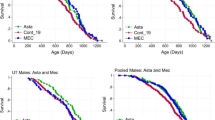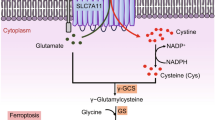Abstract
Queuosine (Q), a hypermodified nucleoside, occurs at the wobble position of transfer RNAs (tRNAs) with GUN anticodons. In eubacteria, absence of Q affects messenger RNA (mRNA) translation and reduces the virulence of certain pathogenic strains. In animal cells, changes in the abundance of Q have been shown to correlate with diverse phenomena including stress tolerance, cell proliferation and tumour growth but the function of Q in animals is poorly understood. Animals are thought to obtain Q (or its analogues) as a micronutrient from dietary sources such as gut microflora. However, the difficulty of maintaining animals under bacteria-free conditions on Q-deficient diets has severely hampered the study of Q metabolism and function in animals. In this study, we show that as in higher animals, tRNAs in the nematode Caenorhabditis elegans are modified by Q and its sugar derivatives. When the worms were fed on Q-deficient Escherichia coli, Q modification was absent from the worm tRNAs suggesting that C. elegans lacks a de novo pathway of Q biosynthesis. The inherent advantages of C. elegans as a model organism, and the simplicity of conferring a Q-deficient phenotype on it make it an ideal system to investigate the function of Q modification in tRNA.
Similar content being viewed by others
Abbreviations
- cAMP:
-
cyclic adenosine monophosphate
- mRNA:
-
messenger RNA
- Q:
-
queuosine
- Tgt:
-
tRNA guanine transglycosylase
- oQ:
-
epoxy-Q
- tRNA:
-
transfer RNA
References
Baranowski W, Dirheimer G, Jakowicki J A and Keith G 1994 Deficiency of queuine, highly modified purine base, in transfer RNAs from primary and metastatic ovarian malignant tumors in women; Cancer Res. 54 4468–4471
Brenner S 1974 The genetics of Caenorhabditis elegans; Genetics 77 71–94
Dineshkumar T K, Thanedar S, Subbulakshmi C, Varshney U 2002 An unexpected absence of queuosine modification in the tRNAs of an Escherichia coli B strain; Microbiology 148 3779–3787
Durand J M, Dagberg B, Uhlin B E, Björk G R 2000 Transfer RNA modification, temperature and DNA superhelicity have a common target in the regulatory network of the virulence of Shigella flexneri: the expression of the virF gene; Mol. Microbiol. 35 924–935
Emmerich B, Zubrod E, Weber H, Maubach P A, Kersten H and Kersten W 1985 Relationship of queuine-lacking transfer RNA to the grade of malignancy in human leukemias and lymphomas; Cancer Res. 45 4308–4314
Frey B, McCloskey J, Kersten W and Kersten H 1988 New function of vitamin B12: cobamide-dependent reduction of epoxyqueuosine to queuosine in tRNAs of Escherichia coli and Salmonella typhimurium; J. Bacteriol. 170 2078–2082
Gaur R and Varshney U 2005 Genetic analysis identifies a function for the queC (ybaX) gene product at an initial step in the queuosine biosynthetic pathway in Escherichia coli; J. Bacteriol. 187 6893–6901
Gehrke C W and Kuo K C 1990 Ribonucleoside analysis by reversed-phase high performance liquid chromatography; in Chromatography and modification of nucleosides. Part A. Analytical methods for major and modified nucleosides (eds) C W Gehrke et al (Amsterdam: Elsevier) 45A pp A3–A71
Gregson J M, Crain P F, Edmonds C G, Gupta R, Hashizume T, Phillipson D W and McCloskey J A 1993 Structure of the archaeal transfer RNA nucleoside G*-15 (2-amino-4,7-dihydro-4-oxo-7-beta-D-ribofuranosyl-1H-pyrrolo[2,3-d]pyrimidine-5-carboximidamide (archaeosine)); J. Biol. Chem. 268 10076–10086
Gunduz U and Katze J R 1984 Queuine salvage in mammalian cells. Evidence that queuine is generated from queuosine 5′-phosphate; J. Biol. Chem. 259 1110–1113
Harada F and Nishimura S 1972 Possible anticodon sequences of tRNAHis, tRNAAsn, and tRNAAsp from Escherichia coli B. Universal presence of nucleoside Q in the first position of the anticondons of these transfer ribonucleic acids; Biochemistry 11 301–308
Haumont E, Nicoghosian K, Grosjean H and Cedergren RJ 1984 The nucleotide sequence of mannosyl-Q-containing tRNAAsp from Xenopus laevis oocytes; Biochimie 66 579–582
Haumont E, Droogmans L and Grosjean H 1987 Enzymatic formation of queuosine and of glycosyl queuosine in yeast tRNAs microinjected into Xenopus laevis oocytes. The effect of the anticodon loop sequence; Eur. J. Biochem. 168 219–225
Iwata-Reuyl D 2003 Biosynthesis of the 7-deazaguanosine hypermodified nucleosides of transfer RNA; Bioorg. Chem. 31 24–43
Kasai H, Kuchino Y, Nihei K and Nishimura S 1975 Distribution of the modified nucleoside Q and its derivatives in animal and plant transfer RNAs; Nucleic Acids Res. 2 1931–1939
Kasai H, Nakanishi K, Macfarlane R D, Torgerson D F, Ohashi Z, McCloskey J A, Gross H J and Nishimura S 1976 Letter: The structure of Q* nucleoside isolated from rabbit liver transfer ribonucleic acid; J. Am. Chem. Soc. 98 5044–5046
Katze J R, Basile B, McCloskey J A 1982 Queuine, a modified base incorporated posttranscriptionally into eukaryotic transfer RNA: wide distribution in nature; Science 216 55–56
Katze J R and Beck W T 1980 Administration of queuine to mice relieves modified nucleoside queuosine deficiency in Ehrlich ascites tumor tRNA; Biochem. Biophys. Res. Commun. 96 313–319
Kersten H 1984 On the biological significance of modified nucleosides in tRNA. Prog. Nucleic Acid Res. Mol. Biol. 31 59–114
Kirtland G M, Morris T D, Moore P H, O’Brian J J, Edmonds C G, McCloskey J A and Katze J R 1988 Novel salvage of queuine from queuosine and absence of queuine synthesis in Chlorella pyrenoidosa and Chlamydomonas reinhardtii; J. Bacteriol. 170 5633–5641
Kuchino Y, Shindo-Okada N, Ando N, Watanabe S and Nishimura S 1981 Nucleotide sequences of two aspartic acid tRNAs from rat liver and rat ascites hepatoma; J. Biol. Chem. 256 9059–9062
Langgut W and Kersten H 1990 The deazaguanine-derivative, queuine, affects cell proliferation, protein phosphorylation and the expression of the proto oncogenes c-fos and c-myc in HeLa cells; FEBS Lett. 265 33–36
Langgut W, Reisser T, Nishimura S and Kersten H 1993 Modulation of mammalian cell proliferation by a modified tRNA base of bacterial origin; FEBS Lett. 336 137–142
Morgan C J, Merrill F L and Trewyn R W 1996 Defective transfer RNA-queuine modification in C3H10T1/2 murine fibroblasts transfected with oncogenic ras; Cancer Res. 56 594–598
Noguchi S, Nishimura Y, Hirota Y and Nishimura S 1982 Isolation and characterization of an Escherichia coli mutant lacking tRNA-guanine transglycosylase. Function and biosynthesis of queuosine in tRNA; J. Biol. Chem. 257 6544–6550
Okada N and Nishimura S 1977 Enzymatic synthesis of Q nucleoside containing mannose in the anticodon of tRNA: isolation of a novel mannosyltransferase from a cell-free extract of rat liver; Nucleic Acids Res. 4 2931–2938
Okada N, Noguchi S, Kasai H, Shindo-Okada N, Ohgi T, Goto T and Nishimura S 1979 Novel mechanism of post-transcriptional modification of tRNA. Insertion of bases of Q precursors into tRNA by a specific tRNA transglycosylase reaction; J. Biol. Chem. 254 3067–3073
Pathak C and Vinayak M 2005 Modulation of lactate dehydrogenase isozymes by modified base queuine; Mol. Biol. Rep. 32 191–196
Pawelkiewicz J, Sroga G E, Starzynska E and Zawielak J 1986 Formation of queuine containing tRNATyr in higher plants; Plant Sci. 47 83–89
Pomerantz S C and McCloskey J A 1990 Analysis of tRNA hydrolysates by liquid chromatography-mass spectrometry; Methods Enzymol. 193 796–824
Randerath E, Agrawal H P and Randerath K 1984 Specific lack of the hypermodified nucleoside, queuosine, in hepatoma mitochondrial aspartate transfer RNA and its possible biological significance; Cancer Res. 44 1167–1171
Reader J S, Metzgar D, Schimmel P and de Crecy-Lagard V 2004 Identification of four genes necessary for biosynthesis of the modified nucleoside queuosine; J. Biol. Chem. 279 6280–6285
Reisser T, Langgut W and Kersten H 1994 The nutrient factor queuine protects HeLa cells from hypoxic stress and improves metabolic adaptation to oxygen availability; Eur. J. Biochem 221 979–986
Reyniers J P, Pleasants J R, Wostmann B S, Katze J R and Farkas W R 1981 Administration of exogenous queuine is essential for the biosynthesis of the queuosine-containing transfer RNAs in the mouse; J. Biol. Chem. 256 11591–11594
Romier C, Meyer J E and Suck D 1997 Slight sequence variations of a common fold explain the substrate specificities of tRNA-guanine transglycosylases from the three kingdoms; FEBS Lett. 416 93–98
Sambrook J, Fritsch E F and Maniatis T 1989 Molecular cloning: A laboratory manual (New York: Cold Spring Harbor Laboratory)
Schachner E and Kersten H 1984 Queuosine deficiency and restoration in Dictyostelium discoideum and related early developmental changes; J. Gen. Microbiol. 130 135–144
Schon A, Gough S and Soll D 1992 Chloroplast tRNA(Asp): nucleotide sequence and variation of in vivo levels during plastid maturation; Plant Mol. Biol. 20 601–607
Siard T J, Jacobson K B and Farkas W R 1991 Queuine metabolism and cadmium toxicity in Drosophila melanogaster; BioFactors (Oxford, England) 3 41–47
Stengl B, Reuter K and Klebe G 2005 Mechanism and substrate specificity of tRNA-guanine transglycosylases (TGTs): tRNA-modifying enzymes from the three different kingdoms of life share a common catalytic mechanism; Chembiochem 6 1926–1939
Sulston J E, Schierenberg E, White J G and Thomson J N 1983 The embryonic cell lineage of the nematode Caenorhabditis elegans; Dev. Biol. 100 64–119
Van Lanen S G, Reader J S, Swairjo M A, de Crecy-Lagard V, Lee B and Iwata-Reuyl D 2005 From cyclohydrolase to oxidoreductase: discovery of nitrile reductase activity in a common fold; Proc. Natl. Acad. Sci. USA 102 4264–4269
Author information
Authors and Affiliations
Corresponding authors
Rights and permissions
About this article
Cite this article
Gaur, R., Björk, G.R., Tuck, S. et al. Diet-dependent depletion of queuosine in tRNAs in Caenorhabditis elegans does not lead to a developmental block. J Biosci 32, 747–754 (2007). https://doi.org/10.1007/s12038-007-0074-4
Received:
Accepted:
Published:
Issue Date:
DOI: https://doi.org/10.1007/s12038-007-0074-4




